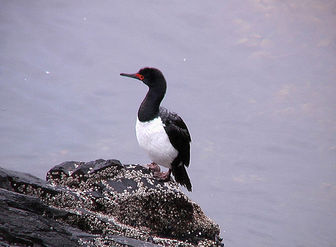Rock Shag
At a distance, the Rock Shag is a black and white bird, with head, neck and upperparts black and chest and underparts white. Closer up, the black areas vary from metallic blue to oily green, and are flecked with white in places. The legs and feet are a pink, fleshy colour, and the bare flesh around the beak and eyes is brick red. In breeding condition, there is a blackish though not very prominent crest on the forehead, and a distinctive white ear patch. There is even less sexual dimorphism than in most cormorant species, but males are 5%-10% larger on most size measurements.

Original source: originally posted to Flickr as Phalacrocorax magellanicus (Rock Cormorant)
Author: Arthur ChapmanPermission(Reusing this file)This image, which was originally posted to Flickr.com, was uploaded to Commons using Flickr upload bot on 21:31, 13 November 2008 (UTC) by Ltshears (talk). On that date it was licensed under the license below.This file is licensed under the Creative Commons Attribution 2.0 Generic license.You are free:to share – to copy, distribute and transmit the work
The Rock Shag is classified as Least Concern. Does not qualify for a more at risk category. Widespread and abundant taxa are included in this category.
At a distance, the Rock Shag is a black and white bird, with head, neck and upperparts black and chest and underparts white. Closer up, the black areas vary from metallic blue to oily green, and are flecked with white in places. The legs and feet are a pink, fleshy colour, and the bare flesh around the beak and eyes is brick red. In breeding condition, there is a blackish though not very prominent crest on the forehead, and a distinctive white ear patch. More
The Rock Shag or Magellanic cormorant is a marine cormorant found around the southernmost coasts of South America. Its breeding range is from around Valdivia, Chile, south to Cape Horn and Tierra del Fuego, and north to Punta Tombo in Argentina. In winter it is seen further north, with individuals reaching as far as Santiago, Chile on the west coast and Uruguay on the east. More
Like all cormorants, the Rock Shag feeds by diving for underwater prey. It feeds close to shore, often diving at the edge of kelp beds and apparently finding small fish sheltering among the weed. Studies with depth gauges suggest that it is a fairly shallow diver, typically going about 5m below the surface with few individuals ever diving deeper than 10m, although its prey mainly come from the sea floor. Dive times are typically around 30 seconds. More

Original source: Arthur Chapman
Author: Arthur Chapman
Permission: Some rights reserved
Family : Phalacrocoracidae
Genus : Phalacrocorax
Species : magellanicus
Authority : (Gmelin, 1789)
